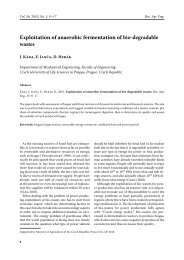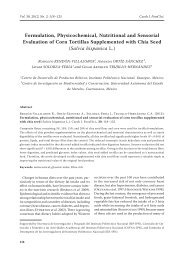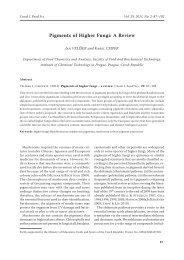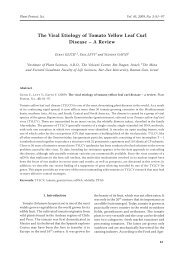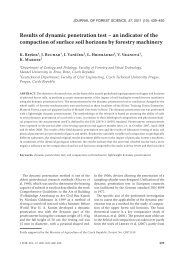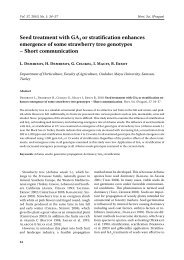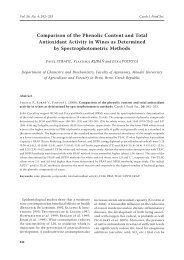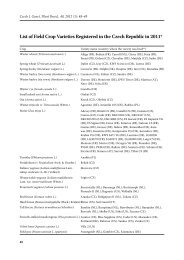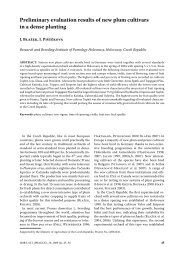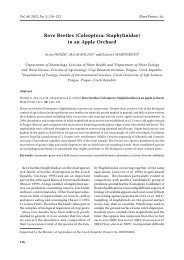Trans Fatty Acid Contents in Chocolates and Chocolate Wafers in ...
Trans Fatty Acid Contents in Chocolates and Chocolate Wafers in ...
Trans Fatty Acid Contents in Chocolates and Chocolate Wafers in ...
Create successful ePaper yourself
Turn your PDF publications into a flip-book with our unique Google optimized e-Paper software.
Czech J. Food Sci. Vol. 28, 2010, No. 3: 177–184<br />
<strong>Trans</strong> <strong>Fatty</strong> <strong>Acid</strong> <strong>Contents</strong> <strong>in</strong> <strong><strong>Chocolate</strong>s</strong> <strong>and</strong> <strong>Chocolate</strong><br />
<strong>Wafers</strong> <strong>in</strong> Turkey<br />
Yavuz Selim Çakmak 1 , Gökalp Özmen Güler 2 <strong>and</strong> abdurrahman aktümSek 1<br />
Abstract<br />
1 Department of Biology, Science Faculty <strong>and</strong> 2 Department of Biological education,<br />
ahmet kelesoglu education Faculty, Selcuk University, konya, turkey<br />
Çakmak Y.S., Güler G.Ö., Aktümsek A. (2010): <strong>Trans</strong> fatty acid contents <strong>in</strong> chocolates <strong>and</strong> chocolate<br />
wafers <strong>in</strong> Turkey. Czech J. Food Sci., 28: 177–184.<br />
<strong>Fatty</strong> acid compositions <strong>and</strong> trans fatty acid contents of chocolate <strong>and</strong> chocolate wafers collected from Turkish markets<br />
were determ<strong>in</strong>ed by GC. Total 62 samples, be<strong>in</strong>g all chocolates <strong>and</strong> chocolate wafers sold <strong>in</strong> Turkey, were <strong>in</strong>vestigated.<br />
35 samples of chocolate which were categorised as milk chocolate, bitter chocolate, chocolate with nuts, chocolate<br />
with pistachio, chocolate with almond, other chocolates, <strong>and</strong> 27 samples of chocolate wafer which were categorised<br />
as pure chocolate wafers <strong>and</strong> chocolate wafers with nuts belong<strong>in</strong>g to 12 different national chocolate br<strong>and</strong>s, were<br />
analysed. Generally, C16:0 palmitic acid, C18:0 stearic acid, <strong>and</strong> C18:1 oleic acid were the major fatty acids <strong>in</strong> all samples.<br />
trans fatty acid contents <strong>in</strong> chocolate wafers samples showed a variation between 0.00–7.92%. trans fatty acids<br />
were determ<strong>in</strong>ed as 0.00–6.23% <strong>in</strong> chocolate samples. In conclusion, it was shown that trans fatty acids contents <strong>in</strong><br />
chocolates were relatively lower than those of other countries.<br />
Keywords: trans fatty acid; fatty acid composition; chocolate; chocolate wafer; Turkey<br />
trans-isomeric fatty acids occur naturally <strong>in</strong><br />
dairy <strong>and</strong> other animal fats by biological hydrogenation<br />
<strong>in</strong> the stomach of rum<strong>in</strong>ants, but they<br />
orig<strong>in</strong>ate ma<strong>in</strong>ly from the <strong>in</strong>dustrial process of<br />
catalytic hydrogenation of fats; 80–90% of dietary<br />
trans fatty acids are derived from this latter<br />
source, whereas 2–8% are provided by dairy<br />
products (Kromer 1976; Mounts 1979). Some<br />
fatty acids have one or more double bonds <strong>in</strong> the<br />
trans configuration: these are the so-called trans<br />
fatty acids (TFAs) (Fritsche & Ste<strong>in</strong>hart 1998).<br />
TFAs are present <strong>in</strong> variable amounts <strong>in</strong> a wide<br />
range of foods, <strong>in</strong>clud<strong>in</strong>g most foods made with<br />
partially hydrogenated oils such as baked goods<br />
<strong>and</strong> fried foods, <strong>and</strong> some margar<strong>in</strong>e products<br />
(Semma 2002). TFAs content varies considerably<br />
among foods, reflect<strong>in</strong>g, the differences <strong>in</strong> the fats<br />
<strong>and</strong> oils used <strong>in</strong> the manufactur<strong>in</strong>g or preparation<br />
processes (Innis et al. 1999).<br />
TFAs <strong>in</strong>crease plasma concentrations of lowdensity<br />
lipoprote<strong>in</strong> cholesterol <strong>and</strong> reduce the<br />
concentrations of high-density lipoprote<strong>in</strong> cholesterol<br />
(Ascherio &Willet 1997). TFAs have<br />
adverse effects on blood lipoprote<strong>in</strong>s, <strong>and</strong> they are<br />
therefore expected to raise the risk of coronary<br />
heart disease (Katan 1998). As a result, the net<br />
effect of TFAs on the ratio of LDL to HDL cholesterol<br />
is approximately double that of the saturated<br />
fatty acids. These adverse effects of TFAs have<br />
been confirmed by other studies (Zock & Katan<br />
Supported by Selcuk University Scientific Research Foundation (BAP), Project No. 06201049.<br />
177
Vol. 28, 2010, No. 3: 177–184 Czech J. Food Sci.<br />
1992; Judd et al. 1994). In addition, there are<br />
concerns about recent suggestions that TFA may<br />
affect human fetal growth <strong>and</strong> <strong>in</strong>fant development<br />
(Ayagari et al. 1996). Also, an association exists<br />
between the prevalence of asthma <strong>and</strong> allergies<br />
<strong>in</strong> children <strong>and</strong> the risk of diabetes <strong>in</strong> adults with<br />
the <strong>in</strong>take of trans isomers (Weil<strong>and</strong> et al. 1999;<br />
Stender & Dyerberg 2004).<br />
Some research has been carried out <strong>in</strong>to TFAs<br />
<strong>in</strong> various foods worldwide (Demmelmair et al.<br />
1996; Wagner et al. 2000; Mojska et al. 2006) <strong>and</strong><br />
<strong>in</strong> Turkey (Demirbas & Yilmaz 2000; Cet<strong>in</strong> et<br />
al. 2003; Daglioglu & Tasan 2003; Karabulut<br />
2007; Basol & Tasan 2008). The most recent study<br />
concern<strong>in</strong>g trans fatty acids <strong>in</strong> Turkey reports<br />
fatty acid compositions of Turkish shorten<strong>in</strong>gs<br />
(Basol & Tasan 2008). The authors stated that<br />
partially hydrogenated vegetable oils with a high<br />
TFA content were still the major raw materials<br />
used <strong>in</strong> the production of Turkish shorten<strong>in</strong>gs.<br />
However, there is limited research (Karabulut<br />
2007) <strong>in</strong>to fatty acids composition <strong>and</strong> trans fatty<br />
acids contents <strong>in</strong> chocolates. Therefore, the objective<br />
of this study is to determ<strong>in</strong>e the fatty acids<br />
compositions <strong>and</strong> trans fatty acids contents <strong>in</strong><br />
all chocolate <strong>and</strong> chocolate wafers br<strong>and</strong>s sold <strong>in</strong><br />
Turkish markets.<br />
178<br />
MATeriAls And MeThods<br />
Sample collection. 35 samples of chocolates<br />
<strong>and</strong> 27 samples of chocolate wafers belong<strong>in</strong>g to<br />
12 different national chocolate br<strong>and</strong>s were analysed<br />
<strong>in</strong> 2007. The chocolates were categorised as<br />
milk chocolates (n = 13), bitter chocolates (n = 4),<br />
chocolates with nuts (n = 8), chocolates with pistachio<br />
(n = 3), chocolates with almond (n = 2),<br />
other chocolates (n = 5), <strong>and</strong> chocolate wafers<br />
were categorised as pure chocolate wafers (n = 14)<br />
<strong>and</strong> chocolate wafers with nuts (n = 13). Total 62<br />
samples were <strong>in</strong>vestigated, be<strong>in</strong>g all chocolate <strong>and</strong><br />
chocolate wafers br<strong>and</strong>s sold <strong>in</strong> Turkey.<br />
<strong>Fatty</strong> acid analysis. The samples of chocolates<br />
<strong>and</strong> chocolate wafers were extracted us<strong>in</strong>g the<br />
Folch et al. (1957) method. The fatty acids <strong>in</strong> the<br />
total lipid were esterified <strong>in</strong>to methyl esters by<br />
saponification with 0.5N methanolic NaOH <strong>and</strong><br />
transesterified with 14% BF 3 (v/v) <strong>in</strong> methanol<br />
(Paquot 1979).<br />
<strong>Fatty</strong> acid methyl esters (FAMEs) were analysed<br />
on a HP (Hewlett Packard, Palo Alto, USA) Agilent<br />
6890N model gas chromatograph (GC), equipped<br />
with a flame ionisation detector (FID) <strong>and</strong> fitted<br />
with a HP-88 capillary column (100 m, 0.25 mm<br />
i.d. <strong>and</strong> 0.2 µm). The <strong>in</strong>jector <strong>and</strong> detector temperatures<br />
were 240°C <strong>and</strong> 250°C, respectively. The<br />
oven was programmed at 160°C <strong>in</strong>itial temperature<br />
<strong>and</strong> 2 m<strong>in</strong> <strong>in</strong>itial time. Thereafter, the temperature<br />
<strong>in</strong>creased by 4°C/m<strong>in</strong> to 185°C, then it <strong>in</strong>creased<br />
by 1°C/m<strong>in</strong> to 200°C <strong>and</strong> was held for 46.75 m<strong>in</strong><br />
at 200°C. Total run time was 70 m<strong>in</strong>utes. Carrier<br />
gas was helium (1 ml/m<strong>in</strong>).<br />
The identification of fatty acids was carried<br />
out by compar<strong>in</strong>g the sample FAME peak relative<br />
retention times with those obta<strong>in</strong>ed for Alltech<br />
(Carolean Industrial Drive, Satate Collage, USA)<br />
st<strong>and</strong>ards. The results were expressed as FID response<br />
area relative percentages. Each reported<br />
result is the average value of three GC analyses.<br />
The results are presented as means ± SD.<br />
resulTs<br />
<strong>Fatty</strong> acids compositions <strong>and</strong> trans fatty acids<br />
contents <strong>in</strong> 35 chocolates (milk chocolates, bitter<br />
chocolates, chocolates with nuts, chocolates<br />
with pistachio, chocolates with almond, <strong>and</strong> other<br />
chocolates) <strong>and</strong> 27 chocolate wafers (pure chocolate<br />
wafers, <strong>and</strong> chocolate wafers with nuts) belong<strong>in</strong>g<br />
to 12 different national br<strong>and</strong>s obta<strong>in</strong>ed from<br />
markets <strong>in</strong> Turkey are presented <strong>in</strong> Tables 1 <strong>and</strong> 2.<br />
The TFA content varied depend<strong>in</strong>g on the chocolate<br />
<strong>and</strong> chocolate wafers groups (Table 3).<br />
Twenty five fatty acids <strong>in</strong> chocolates <strong>and</strong> chocolate<br />
wafers lipids were identified <strong>and</strong> evaluated.<br />
Palmitic acid, stearic acid, <strong>and</strong> oleic acid were<br />
high <strong>in</strong> chocolates <strong>and</strong> chocolate wafers. Oleic<br />
acid was the major fatty acids <strong>in</strong> all samples except<br />
for bitter chocolate (Tables 1 <strong>and</strong> 2).<br />
Palmitic <strong>and</strong> stearic acids were the major saturated<br />
fatty acids (SFA) <strong>in</strong> chocolates <strong>and</strong> chocolate<br />
wafers. Palmitic <strong>and</strong> stearic acids ranged between<br />
20.39–25.80% <strong>and</strong> 25.77–34.66% <strong>in</strong> chocolate<br />
groups, <strong>and</strong> 24.89–26.52% <strong>and</strong> 17.86–21.10% <strong>in</strong><br />
chocolate wafers groups, respectively (Tables 1<br />
<strong>and</strong> 2). High amounts of lauric acid were determ<strong>in</strong>ed<br />
<strong>in</strong> pure chocolate wafers (5.11%) <strong>and</strong> chocolate<br />
wafers with nuts (4.08%).<br />
Oleic acid was the major monounsaturated fatty<br />
acid (MUFA) <strong>in</strong> all samples. Oleic acid was found<br />
to amount to 43.33%, 38.49%, 36.88%, 36.39%,<br />
33.80%, 33.16%, 32.99%, <strong>and</strong> 32.31%, <strong>in</strong> chocolates
Czech J. Food Sci. Vol. 28, 2010, No. 3: 177–184<br />
Table 1. <strong>Fatty</strong> acid composition <strong>and</strong> trans fatty acid content of analysed chocolates (mean ± SD)<br />
Milk chocolate Bitter chocolate <strong>Chocolate</strong> with <strong>Chocolate</strong> with <strong>Chocolate</strong> with Other chocolate All chocolates<br />
<strong>Fatty</strong> acids<br />
(n = 13)<br />
(n = 4)<br />
nuts (n = 8) pistachio (n = 3) almond (n = 2) (n = 5)<br />
(n = 35)<br />
C 8:0 0.13 ± 0.19 0.02 ± 0.01 0.01 ± 0.04 – – 0.026 ± 0.13<br />
C 10:0 0.50 ± 0.50 0.17 ± 0.09 0.30 ± 0.22 0.64 ± 0.08 0.93 ± 0.02 0.13 ± 0.12 0.447 ± 0.45<br />
C 11:0 0.06 ± 0.08 0.01 ± 0.01 0.05 ± 0.04 0.05 ± 0.05 0.14 ± 0.01 0.01 ± 0.02 0.056 ± 0.07<br />
C 12:0 0.56 ± 0.29 0.37 ± 0.06 0.36 ± 0.17 0.36 ± 0.14 1.10 ± 0.03 1.63 ± 1.32 0.729 ± 0.66<br />
C 13:0 0.02 ± 0.02 – 0.02 ± 0.01 0.02 ± 0.02 0.03 ± 0.01 – 0.015 ± 0.02<br />
C 14:0 1.71 ± 0.34 0.48 ± 0.06 1.24 ± 0.32 1.17 ± 0.20 1.66 ± 0.04 1.67 ± 0.53 1.320 ± 0.52<br />
C 15:0 0.13 ± 0.10 0.06 ± 0.01 0.02 ± 0.03 0.04 ± 0.01 0.01 ± 0.01 0.10 ± 0.06 0.059 ± 0.08<br />
C 16:0 25.70 ± 1.78 25.11 ± 0.17 20.39 ± 2.20 22.91 ± 0.92 23.65 ± 0.21 25.80 ± 2.73 23.925 ± 3.04<br />
C 17:0 0.29 ± 0.04 0.22 ± 0.01 0.21 ± 0.04 0.22 ± 0.03 0.23 ± 0.01 0.24 ± 0.07 0.235 ± 0.05<br />
C 18:0 31.10 ± 2.24 34.66 ± 0.34 25.11 ± 4.89 25.77 ± 6.89 25.95 ± 1.63 26.73 ± 1.58 28.220 ± 5.00<br />
C 20:0 0.03 ± 0.08 – 0.06 ± 0.11 – – 0.21 ± 0.26 0.048 ± 0.12<br />
Σ SFA 60.23 ± 3.01 61.10 ± 0.27 47.77 ± 6.50 51.18 ± 7.37 53.70 ± 1.75 56.52 ± 3.70 55.080 ± 7.12<br />
C 14:1 n5 0.21 ± 0.05 0.04 ± 0.01 0.15 ± 0.05 0.14 ± 0.01 0.18 ± 0.01 0.10 ± 0.06 0.135 ± 0.07<br />
C 15:1 n5 0.06 ± 0.02 0.01 ± 0.01 0.05 ± 0.03 0.06 ± 0.01 0.05 ± 0.01 0.01 ± 0.01 0.040 ± 0.03<br />
C 16:1 n7 0.62 ± 0.09 0.30 ± 0.04 0.42 ± 0.15 0.51 ± 0.09 0.49 ± 0.01 0.39 ± 0.09 0.455 ± 0.15<br />
C 17:1 n8 0.08 ± 0.02 0.03 ± 0.01 0.08 ± 0.01 0.07 ± 0.01 0.07 ± 0.01 0.05 ± 0.01 0.062 ± 0.02<br />
C 18:1 n9 33.16 ± 2.51 33.80 ± 0.60 43.33 ± 5.61 38.49 ± 5.46 36.39 ± 1.28 32.31 ± 2.82 36.246 ± 5.74<br />
C 20:1 n9 0.17 ± 0.05 0.04 ± 0.03 0.08 ± 0.09 0.24 ± 0.05 0.13 ± 0.01 0.08 ± 0.04 0.124 ± 0.08<br />
Σ MUFA 34.30 ± 2.44 34.22 ± 0.52 44.11 ± 5.49 39.51 ± 5.61 37.31 ± 1.32 32.94 ± 2.92 37.062 ± 5.70<br />
C 18:2 n6 3.89 ± 0.87 3.33 ± 0.21 5.82 ± 1.44 7.45 ± 2.04 6.95 ± 0.48 9.00 ± 4.76 6.074 ± 2.68<br />
C 18:3 n6 0.69 ± 0.33 0.76 ± 0.29 0.72 ± 0.22 0.76 ± 0.35 0.77 ± 0.08 0.12 ± 0.25 0.638 ± 0.34<br />
C 18:3 n3 0.45 ± 0.29 0.43 ± 0.21 0.21 ± 0.05 0.43 ± 0.02 0.21 ± 0.01 0.92 ± 0.40 0.445 ± 0.32<br />
C 20:4 n6 0.02 ± 0.06 – – 0.06 ± 0.01 – 0.13 ± 0.11 0.034 ± 0.07<br />
Σ PUFA 5.05 ± 0.80 4.52 ± 0.29 6.75 ± 1.28 8.70 ± 1.71 7.93 ± 0.40 10.17 ± 4.87 7.191 ± 2.64<br />
C 16:1 t9 0.03 ± 0.04 – 0.06 ± 0.03 0.07 ± 0.01 0.05 ± 0.01 0.02 ± 0.02 0.037 ± 0.04<br />
C 18:1 t9 0.11 ± 0.17 – 0.72 ± 1.65 0.22 ± 0.01 0.61 ± 0.01 0.06 ± 0.13 0.287 ± 0.85<br />
C 18:2 t9t12 0.04 ± 0.03 – 0.19 ± 0.42 0.06 ± 0.01 0.06 ± 0.01 0.05 ± 0.04 0.066 ± 0.21<br />
C 18:2 t9c12 – – 0.05 ± 0.06 0.02 ± 0.01 0.04 ± 0.01 – 0.017 ± 0.04<br />
Σ TFA 0.18 ± 0.20 – 1.02 ± 2.12 0.37 ± 0.01 0.76 ± 0.01 0.13 ± 0.12 0.407 ± 1.09<br />
Other 0.24 ± 0.14 0.16 ± 0.04 0.35 ± 0.17 0.24 ± 0.05 0.30 ± 0.03 0.24 ± 0.18 0.260 ± 0.17<br />
SFA – saturated fatty acid; MUFA – monounsaturated fatty acid; PUFA – polyunsaturated fatty acid; TFA – trans fatty acid; Other – unknown peak<br />
179
Vol. 28, 2010, No. 3: 177–184 Czech J. Food Sci.<br />
Table 2. <strong>Fatty</strong> acid composition <strong>and</strong> trans fatty acid content of analysed chocolate wafers (mean ± SD)<br />
<strong>Fatty</strong> acids Pure chocolate wafers (n = 14) Nut chocolate wafers (n = 13) All chocolate wafers (n = 27)<br />
C 8:0 0.20 ± 0.33 0.21 ± 0.51 0.201 ± 0.37<br />
C 10:0 0.51 ± 0.53 0.42 ± 0.68 0.466 ± 0.57<br />
C 11:0 0.03 ± 0.03 0.01 ± 0.01 0.018 ± 0.02<br />
C 12:0 5.11 ± 9.90 4.08 ± 8.53 4.595 ± 8.77<br />
C 13:0 0.02 ± 0.02 0.01 ± 0.01 0.015 ± 0.02<br />
C 14:0 2.97 ± 3.86 2.14 ± 2.70 2.553 ± 3.26<br />
C 15:0 0.06 ± 0.08 0.06 ± 0.04 0.060 ± 0.07<br />
C 16:0 26.52 ± 5.24 24.89 ± 5.42 25.705 ± 5.16<br />
C 17:0 0.18 ± 0.06 0.15 ± 0.04 0.167 ± 0.06<br />
C 18:0 21.10 ± 5.65 17.86 ± 4.82 19.479 ± 5.55<br />
C 20:0 0.04 ± 0.08 0.10 ± 0.15 0.068 ± 0.12<br />
Σ SFA 56.74 ± 9.85 49.93 ± 13.32 53.327 ± 11.50<br />
C 14:1 n5 0.12 ± 0.08 0.06 ± 0.03 0.094 ± 0.07<br />
C 15:1 n5 0.04 ± 0.03 0.02 ± 0.03 0.029 ± 0.04<br />
C 16:1 n7 0.37 ± 0.17 0.26 ± 0.12 0.316 ± 0.16<br />
C 17:1 n8 0.05 ± 0.03 0.04 ± 0.02 0.045 ± 0.02<br />
C 18:1 n9 32.99 ± 8.51 36.88 ± 10.85 34.932 ± 9.63<br />
C 20:1 n9 0.11 ± 0.06 0.13 ± 0.15 0.121 ± 0.12<br />
Σ MUFA 33.68 ± 8.61 37.39 ± 11.00 35.537 ± 9.74<br />
C 18:2 n6 7.69 ± 2.31 10.28 ± 4.78 8.989 ± 3.68<br />
C 18:3 n6 0.55 ± 0.22 0.29 ± 0.27 0.417 ± 0.29<br />
C 18:3 n3 0.37 ± 0.07 0.55 ± 0.38 0.463 ± 0.30<br />
C 20:4 n6 0.01 ± 0.01 0.02 ± 0.03 0.011 ± 0.03<br />
Σ PUFA 8.62 ± 2.29 11.14 ± 4.97 9.880 ± 3.76<br />
C 16:1 t9 0.03 ± 0.03 0.03 ± 0.07 0.027 ± 0.06<br />
C 18:1 t9 0.56 ± 0.87 1.19 ± 2.06 0.874 ± 1.55<br />
C 18:2 t9t12 0.03 ± 0.03 0.13 ± 0.26 0.080 ± 0.19<br />
C 18:2 t9c12 0.03 ± 0.04 0.04 ± 0.10 0.038 ± 0.07<br />
Σ TFA 0.65 ± 0.90 1.39 ± 2.38 1.019 ± 1.77<br />
Other 0.32 ± 0.16 0.16 ± 0.15 0.237 ± 0.17<br />
SFA – saturated fatty acid; MUFA – monounsaturated fatty acid; PUFA – polyunsaturated fatty acid; TFA – trans fatty acid;<br />
Other – unknown peak<br />
with nuts, chocolates with pistachio, chocolate<br />
wafers with nuts, chocolates with almond, bitter<br />
chocolates, milk chocolates, pure chocolate wafers,<br />
<strong>and</strong> other chocolates groups, respectively. The<br />
percentage of oleic acid was found to be 36.246%<br />
<strong>and</strong> 34.932% <strong>in</strong> chocolates <strong>and</strong> chocolate wafers<br />
groups, respectively (Tables 1 <strong>and</strong> 2).<br />
180<br />
L<strong>in</strong>oleic acid was the primary polyunsaturated<br />
fatty acid (PUFA) <strong>in</strong> all samples. This fatty acid was<br />
found to represent 10.28%, 9.00%, 7.69%, 7.45%,<br />
6.95%, 5.82%, 3.89%, <strong>and</strong> 3.33%, <strong>in</strong> chocolate wafers<br />
with nuts, other chocolates, pure chocolate<br />
wafers, chocolates with pistachio, chocolates with<br />
almond, chocolates with nuts, milk chocolates,
Czech J. Food Sci. Vol. 28, 2010, No. 3: 177–184<br />
Table 3. M<strong>in</strong>imum <strong>and</strong> maximum range of fatty acid composition <strong>and</strong> trans fatty acid content of chocolate <strong>and</strong> chocolate wafers<br />
<strong>Chocolate</strong> wafers<br />
with nuts (n = 13)<br />
Pure chocolate<br />
wafers (n = 14)<br />
Other chocolate<br />
(n = 5)<br />
<strong>Chocolate</strong> with<br />
almond (n = 2)<br />
<strong>Chocolate</strong> with<br />
pistachio (n = 3)<br />
<strong>Chocolate</strong> with<br />
nuts (n = 8)<br />
Bitter chocolate<br />
(n = 4)<br />
Milk chocolate<br />
(n = 13)<br />
<strong>Fatty</strong> acids<br />
C 8:0 0.00–0.62 0.00–0.07 0.00–0.10 – – – 0.00–1.17 0.00–1.84<br />
C 10:0 0.10–2.10 0.03–0.33 0.04–0.74 0.00–1.04 0.96–0.99 0.00–0.31 0.00–2.07 0.00–2.35<br />
C 11:0 0.00–0.30 0.00–0.06 0.00–0.11 0.00–0.12 0.08–0.09 0.00–0.06 0.00–0.09 0.00–0.03<br />
C 12:0 0.31–1.42 0.11–1.01 0.17–0.60 0.18–0.45 0.32–0.36 0.40–3.66 0.33–38.76 0.22–31.90<br />
C 13:0 0.00–0.06 0.00–0.01 0.00–0.03 0.00–0.04 0.03 0.00–0.01 0.00–0.05 0.00–0.05<br />
C 14:0 0.94–2.15 0.22–1.07 0.68–1.75 1.01–1.44 1.25–1.31 0.98–2.27 0.91–15.95 0.63–10.90<br />
C 15:0 0.00–0.22 0.04–0.09 0.00–0.09 0.01–0.11 0.01 0.00–0.17 0.00–0.21 0.00–0.11<br />
C 16:0 21.87–29.98 24.37–25.53 16.97–24.87 20.79–25.32 21.41–21.71 21.99–28.35 14.10–35.02 15.38–36.28<br />
C 17:0 0.22–0.35 0.22–0.23 0.16–0.25 0.16–0.28 0.25–0.26 0.16–0.34 0.04–0.29 0.05–0.24<br />
C 18:0 26.28–33.49 30.51–36.51 17.27–32.81 16.97–37.06 27.88–30.18 24.51–29.38 14.56–29.41 12.95–28.18<br />
C 20:0 0.00–0.30 – 0.00–0.25 – – 0.00–0.54 0.00–0.28 0.00–0.42<br />
Σ SFA 51.32–62.81 57.75–62.54 38.46–57.96 43.99–62.14 52.33–54.78 50.04–59.73 45.09–83.68 34.75–87.18<br />
C 14:1 n5 0.11–0.27 0.01–0.09 0.08–0.22 0.10–0.17 0.16–0.17 0.02–0.18 0.01–0.27 0.01–0.13<br />
C 15:1 n5 0.04–0.11 0.00–0.04 0.01–0.12 0.05–0.09 0.05 0.00–0.03 0.00–0.10 0.00–0.12<br />
C 16:1 n7 0.43–0.74 0.22–0.39 0.12–0.62 0.44–0.63 0.55–0.57 0.29–0.48 0.04–0.68 0.00–0.45<br />
C 17:1 n8 0.04–0.13 0.00–0.04 0.06–0.10 0.05–0.09 0.08–0.09 0.03–0.06 0.00–0.09 0.00–0.06<br />
C 18:1 n9 31.29–40.03 32.27–37.02 34.21–53.34 31.58–42.49 37.04–38.85 27.61–34.48 8.40–44.01 7.57–52.50<br />
C 20:1 n9 0.09–0.25 0.00–0.12 0.00–0.19 0.20–0.30 0.25–0.27 0.02–0.13 0.00–0.20 0.00–0.61<br />
Σ MUFA 32.16–41.10 32.70–37.70 35.25–53.87 32.50–43.74 38.12–40.00 28.06–35.18 8.45–44.58 7.62–53.01<br />
C 18:2 n6 3.06–6.03 2.95–3.67 3.96–8.75 2.99–12.31 5.03–5.71 4.17–14.05 3.48–12.34 4.03–18.96<br />
C 18:3 n6 0.01–0.99 0.34–0.96 0.45–1.17 0.31–1.34 0.87–0.99 0.00–0.56 0.01–0.86 0.02–0.81<br />
C 18:3 n3 0.24–1.19 0.30–0.77 0.14–0.29 0.22–0.82 0.24–0.25 0.24–1.25 0.21–1.18 0.16–1.53<br />
C 20:4 n6 0.00–0.20 – – 0.00–0.17 – 0.00–0.23 0.00–0.09 0.00–0.12<br />
Σ PUFA 4.25–7.04 4.09–4.98 5.35–9.51 4.55–13.60 6.26–6.83 4.96–15.24 4.34–13.61 4.32–20.52<br />
C 16:1 t9 0.00–0.10 – 0.00–0.09 0.00–0.11 0.10 0.00–0.06 0.00–0.07 0.00–0.27<br />
C 18:1 t9 0.00–0.40 – 0.00–4.77 0.00–0.34 0.33 0.00–0.29 0.00–2.66 0.00–6.64<br />
C 18:2 t9t12 0.00–0.09 0.00–0.01 0.00–1.23 0.02–0.13 0.02 0.00–0.10 0.00–0.09 0.00–0.94<br />
C 18:2 t9c12 0.00–004 – 0.00–0.19 0.00–0.03 0.02–0.03 – 0.00–0.10 0.00–0.33<br />
Σ TFA 0.00–0.53 0.00–0.01 0.00–6.23 0.13–0.48 0.48 0.00–0.35 0.00–2.90 0.00–7.92<br />
Other 0.06–0.47 0.00–0.48 0.05–0.57 0.00–0.38 0.35–0.36 0.00–0.47 0.09–0.66 0.01–0.51<br />
SFA – saturated fatty acid; MUFA – monounsaturated fatty acid; PUFA – polyunsaturated fatty acid; TFA – trans fatty acid; Other – unknown peak<br />
181
Vol. 28, 2010, No. 3: 177–184 Czech J. Food Sci.<br />
<strong>and</strong> bitter chocolates groups, respectively. The<br />
percentage of l<strong>in</strong>oleic acid found was 6.074% <strong>and</strong><br />
8.989% <strong>in</strong> chocolate <strong>and</strong> chocolate wafers groups,<br />
respectively (Tables 1 <strong>and</strong> 2).<br />
SFAs contents were found to be higher than<br />
those of MUFAs <strong>and</strong> PUFAs <strong>in</strong> all samples <strong>and</strong><br />
were determ<strong>in</strong>ed to be 61.10%, 60.23%, 56.74%,<br />
56.52%, 53.70%, 51.18%, 49.93%, <strong>and</strong> 47.77%, <strong>in</strong><br />
bitter chocolates, milk chocolates, pure chocolate<br />
wafers, other chocolates, chocolates with almond,<br />
chocolates with pistachio, chocolate wafers with<br />
nuts, <strong>and</strong> chocolates with nuts, respectively. The<br />
percentage of SFA was found to be 55.08%, <strong>and</strong><br />
53.327% <strong>in</strong> chocolate <strong>and</strong> chocolate wafers groups,<br />
respectively (Tables 1 <strong>and</strong> 2).<br />
In our study, the percentages of C 16:1 t9, C 18:1 t9,<br />
C 18:2 t9t12, <strong>and</strong> C 18:2 t9c12 ranged from 0.00% to<br />
0.07%, 0.00% to 0.72%, 0.00% to 0.19%, <strong>and</strong> 0.00% to<br />
0.05%, <strong>in</strong> chocolates groups, respectively (Table 1).<br />
The percentages of C 16:1 t9, C 18:1 t9, C 18:2 t9t12,<br />
<strong>and</strong> C 18:2 t9c12 ranged from 0.03% to 0.03%, 0.56%<br />
to 1.19%, 0.03% to 0.13%, <strong>and</strong> 0.03% to 0.04%, <strong>in</strong><br />
chocolate wafers groups, respectively (Table 2).<br />
Total trans fatty acids contents were found to be<br />
higher <strong>in</strong> chocolate wafers with nuts than <strong>in</strong> other<br />
samples (1.39%). C 18:1 t9 elaidic acid, was found to<br />
be the most abundant trans fatty acid <strong>in</strong> all samples.<br />
TFAs were found <strong>in</strong> all samples of milk chocolates,<br />
pure chocolate wafers, other chocolates, chocolates<br />
with pistachio, chocolates with almond, chocolate<br />
wafers with nuts <strong>and</strong> chocolates with nuts but none<br />
of the TFAs was determ<strong>in</strong>ed <strong>in</strong> bitter chocolates.<br />
M<strong>in</strong>imum <strong>and</strong> maximum ranges of TFAs were determ<strong>in</strong>ed<br />
as 0.00–6.23% <strong>in</strong> the chocolate samples<br />
<strong>and</strong> 0.00–7.92% <strong>in</strong> the wafer chocolate samples<br />
(Table 3). The percentages of TFAs were determ<strong>in</strong>ed<br />
as 0.407% <strong>and</strong> 1.019% <strong>in</strong> chocolates <strong>and</strong> chocolate<br />
wafers groups, respectively (Tables 1 <strong>and</strong> 2).<br />
182<br />
disCussion<br />
Tarkowski <strong>and</strong> Kowalczyk (2007) <strong>in</strong>vestigated<br />
the fatty acids contents <strong>in</strong> milk chocolates marketed<br />
<strong>in</strong> Pol<strong>and</strong>. They analysed fourteen chocolate<br />
samples. It was observed that palmitic, stearic,<br />
oleic, <strong>and</strong> l<strong>in</strong>oleic acids were the predom<strong>in</strong>ant fatty<br />
acids. Similarly, <strong>in</strong> our study, oleic, stearic, palmitic,<br />
<strong>and</strong> l<strong>in</strong>oleic acids were the major fatty acids with<br />
proportions of 36.246%, 28.22%, 23.925%, <strong>and</strong><br />
6.074%, <strong>in</strong> chocolate groups, <strong>and</strong> 34.932%, 19.479%,<br />
25.705%, <strong>and</strong> 8.989% <strong>in</strong> chocolate wafers groups,<br />
respectively. Tarkowski <strong>and</strong> Kowalczyk (2007)<br />
also observed that the chocolates supplemented<br />
with nuts had higher oleic <strong>and</strong> l<strong>in</strong>oleic acids contents.<br />
Similarly, <strong>in</strong> our study, oleic acid was also<br />
found to be conta<strong>in</strong>ed <strong>in</strong> the highest proportion<br />
<strong>in</strong> chocolates with nuts (43.33%).<br />
Demmelmair et al. (1996) <strong>in</strong>vestigated TFAs<br />
contents <strong>in</strong> 42 different br<strong>and</strong>s of spreads <strong>and</strong> cold<br />
meats <strong>in</strong>clud<strong>in</strong>g chocolate spreads consumed by<br />
German children (4–7 years old). They determ<strong>in</strong>ed<br />
trans fatty acid content <strong>in</strong> chocolate spreads <strong>in</strong> the<br />
range of 0.7–11.1%. In our study, TFAs content was<br />
relatively lower than <strong>in</strong> their f<strong>in</strong>d<strong>in</strong>gs. We observed<br />
that TFAs content was 0.0–6.23% <strong>in</strong> chocolates<br />
<strong>and</strong> 0.00–7.92% <strong>in</strong> chocolate wafers.<br />
Wagner et al. (2000) <strong>in</strong>vestigated the contents<br />
of TFAs <strong>in</strong> margar<strong>in</strong>es, plant oils, fried products,<br />
<strong>and</strong> chocolate spreads <strong>in</strong> Austria. They observed<br />
that the levels of TFAs were 0.6–8.9% (mean 4.9%)<br />
<strong>in</strong> chocolate spreads. They suggested the use of<br />
partially hydrogenated fats <strong>in</strong> the manufacture of<br />
these spreads. In our study, we determ<strong>in</strong>ed that<br />
TFAs contents were 0.00–6.23% (mean 0.407%)<br />
<strong>in</strong> chocolates <strong>and</strong> 0.00–7.92% (mean 1.019%) <strong>in</strong><br />
chocolate wafers. Thus, TFAs content <strong>in</strong> chocolates<br />
was <strong>in</strong> Turkey relatively lower than <strong>in</strong> Austria.<br />
Wagner et al. (2000) observed that SFA values for<br />
these spreads ranged between 11.9% <strong>and</strong> 29.4%,<br />
with a mean value of 22.4%. Their observed MUFA<br />
values ranged between 29.0% <strong>and</strong> 43.2% with the<br />
mean value 36.5%, <strong>and</strong> PUFA values ranged between<br />
31.30% <strong>and</strong> 41.90% with the mean value<br />
36.2%. In our study, SFA content was observed as<br />
38.46%–62.81% <strong>in</strong> chocolates <strong>and</strong> 34.75–87.18% <strong>in</strong><br />
chocolate wafers. MUFA content was determ<strong>in</strong>ed<br />
as 28.06%–53.87% <strong>in</strong> chocolates <strong>and</strong> 7.62–53.01%<br />
<strong>in</strong> chocolate wafers. PUFA content was observed,<br />
to be 4.09%–15.24% <strong>in</strong> chocolates <strong>and</strong> 4.32–20.52%<br />
<strong>in</strong> chocolate wafers (Table 3). Indicat<strong>in</strong>g that, SFA<br />
levels were higher <strong>in</strong> Turkey than <strong>in</strong> Austria but<br />
PUFA levels were lower than <strong>in</strong> Austria.<br />
Karabulut (2007) <strong>in</strong>vestigated fatty acids compositions<br />
<strong>and</strong> TFAs contents <strong>in</strong> 134 frequently<br />
consumed foods <strong>in</strong>clud<strong>in</strong>g 19 samples of chocolates<br />
<strong>in</strong> Turkey. The author categorised 7 groups of<br />
chocolates. He stated that chocolate samples conta<strong>in</strong>ed<br />
TFAs less than 0.17 g/100 g fatty acids, with<br />
the exceptional national product of chocolate bars<br />
<strong>and</strong> hazelnut cocoa cream (2.03 <strong>and</strong> 3.68 g/100 g<br />
fatty acids, respectively). He observed that the<br />
dark <strong>and</strong> bitter chocolate samples were found<br />
as trans free products <strong>in</strong> their categories. In our
Czech J. Food Sci. Vol. 28, 2010, No. 3: 177–184<br />
study, we analysed more chocolate samples for<br />
fatty acids composition <strong>and</strong> TFAs content than did<br />
Karabulut (2007). Similarly, we found that bitter<br />
chocolates were trans free products. Karabulut<br />
(2007) found that chocolate bar <strong>and</strong> coconut bar<br />
covered with chocolate conta<strong>in</strong>ed the highest lauric<br />
acid (24.87–13.60%) <strong>and</strong> myristic acid (9.38–9.27%)<br />
contents. Similarly, <strong>in</strong> our study, pure chocolate<br />
wafers <strong>and</strong> chocolate wafers with nuts conta<strong>in</strong>ed<br />
higher levels of lauric (5.11–4.08%) <strong>and</strong> myristic<br />
(2.97–2.14%) acids than other groups.<br />
Mojska et al. (2006) determ<strong>in</strong>ed TFAs <strong>in</strong> foods <strong>in</strong><br />
Pol<strong>and</strong> <strong>in</strong>clud<strong>in</strong>g 12 chocolate products. TFAs were<br />
detected to make 7.86% <strong>in</strong> the chocolate products.<br />
We observed that the m<strong>in</strong>imum–maximum range<br />
of TFAs content was 0.00–6.23% for chocolates <strong>and</strong><br />
0.00–7.92% for chocolate wafers. Innis et al. (1999)<br />
determ<strong>in</strong>ed TFAs content <strong>in</strong> over 200 foods <strong>in</strong>clud<strong>in</strong>g<br />
9 chocolate bars <strong>in</strong> Canada. They observed that<br />
TFAs content varied between 0.1% <strong>and</strong> 35.9% with<br />
average values 9.16% <strong>in</strong> chocolate bars. They stated<br />
that the use of average values for theTFAs content<br />
<strong>in</strong> a food category was of a limited value.<br />
Fu et al. (2008) <strong>in</strong>vestigated TFAs <strong>in</strong> nationalbr<strong>and</strong><br />
western-style products <strong>in</strong>clud<strong>in</strong>g 10 chocolate<br />
samples <strong>in</strong> Ch<strong>in</strong>a. The authors determ<strong>in</strong>ed<br />
the average contents of TFAs as 0.80%, 0.57%, <strong>and</strong><br />
1.87% of total fatty acids <strong>in</strong> chocolate with nuts,<br />
dark chocolate, <strong>and</strong> milk chocolate, respectively.<br />
In our study, we determ<strong>in</strong>ed the average TFAs<br />
contents as 1.02%, 0.00%, <strong>and</strong> 0.18% of total fatty<br />
acids <strong>in</strong> chocolate with nuts, bitter chocolate, <strong>and</strong><br />
milk chocolate, respectively.<br />
The body of short-term r<strong>and</strong>omised feed<strong>in</strong>g<br />
trials suggest that cocoa <strong>and</strong> chocolate may exert<br />
beneficial effects on cardiovascular risk via<br />
lower<strong>in</strong>g the blood pressure, anti-<strong>in</strong>flammation,<br />
anti-platelet function, higher HDL, <strong>and</strong> decreased<br />
LDL oxidation (D<strong>in</strong>g et al. 2006). Similarly, Mursu<br />
et al. (2004) stated that cocoa polyphenols may<br />
<strong>in</strong>crease the concentration of HDL cholesterol.<br />
The consumption of cocoa with dark chocolate<br />
<strong>in</strong>creased the serum concentration of HDL cholesterol<br />
by 4% (Wan et al. 2001). Cocoa butter, a<br />
fat derived from cocoa plants <strong>and</strong> predom<strong>in</strong>antly<br />
found <strong>in</strong> dark chocolate (Kris-Etherton et al.<br />
1993) conta<strong>in</strong>s on average 33% of oleic acid, 25%<br />
of palmitic acid, <strong>and</strong> 33% of stearic acid (USDA<br />
National Nutrient Database http://www.nal.usda.<br />
gov/fnic/foodcomp/search/). Similarly, <strong>in</strong> our<br />
study, <strong>in</strong> bitter chocolates, palmitic, oleic, <strong>and</strong><br />
stearic acids contents were determ<strong>in</strong>ed as 25.11%,<br />
33.80%, <strong>and</strong> 34.66%, respectively. Stearic acid was<br />
suggested to be a non-atherogenic type of dietary<br />
saturated fat (D<strong>in</strong>g et al. 2006) <strong>and</strong> the most recent<br />
trial also shows the effects of stearic acid on lipids<br />
to be even similar to those of oleic <strong>and</strong> l<strong>in</strong>oleic<br />
acids (Thijssen & Mens<strong>in</strong>k 2005).<br />
The results of this research have demonstrated<br />
that fatty acids composition <strong>and</strong> TFAs contents<br />
of chocolate vary. As a result of the extensive coverage<br />
of the present research which <strong>in</strong>cluded all<br />
chocolate <strong>and</strong> chocolate wafers br<strong>and</strong>s <strong>in</strong> Turkey, it<br />
was shown that trans fatty acid levels <strong>in</strong> chocolates<br />
<strong>and</strong> chocolate wafers on Turkish markets were<br />
relatively lower than those of other countries.<br />
r e f e r e n c e s<br />
Ascherio A., Willet W.C. (1997): Health effects of<br />
trans fatty acids. American Journal of Cl<strong>in</strong>ical Nutrition,<br />
66: 1006–1010.<br />
Ayagari A., Peepies J.M., Carlson S.E. (1996): Relationship<br />
of isomeric-fatty acids <strong>in</strong> human cord blood to<br />
N3 <strong>and</strong> N6 status. Pediatric Research, 39: 1808–1808<br />
(Abstract).<br />
Basol B., Tasan M. (2008): <strong>Fatty</strong> acid compositions of<br />
Turkish shorten<strong>in</strong>gs with emphasis on trans fatty acids.<br />
Journal of Food Lipids, 15: 240–250.<br />
Cet<strong>in</strong> M., Yildirim A., Sah<strong>in</strong> A.M. (2003): Determ<strong>in</strong>ation<br />
of fatty acids <strong>and</strong> some undesirable fatty acid isomers<br />
<strong>in</strong> selected Turkish margar<strong>in</strong>es. European Journal<br />
of Lipid Science <strong>and</strong> Technology, 105: 683–687.<br />
Daglioglu O., Tasan M. (2003): <strong>Fatty</strong> acid composition<br />
of traditional fermented <strong>and</strong> unfermented Turkish corn<br />
bread with the emphasis on trans fatty acids. European<br />
Food Research <strong>and</strong> Technology, 217: 125–127.<br />
Demirbas A., Yilmaz N. (2000): trans fatty acid content<br />
of edible margar<strong>in</strong>es <strong>in</strong> Turkey. Deutsche Lebensmittel-Rundschau,<br />
96: 136–138.<br />
Demmelmair H., Festl B., Wolfram G., Koletzko<br />
B. (1996): trans fatty acid contents <strong>in</strong> spreads <strong>and</strong><br />
cold cuts usually consumed by children. Zeitschrift<br />
für Ernährungswissenschaft, 35: 235–240.<br />
D<strong>in</strong>g E.L., Hutfless S.M., D<strong>in</strong>g X., Girotra S. (2006):<br />
<strong>Chocolate</strong> <strong>and</strong> prevention of cardiovascular disease: A<br />
systematic review. Nutrition & Metabolism, 3: 1–12.<br />
Folch J., Lees M., Sloane Stanley G.H. (1957): A<br />
simple method for the isolation <strong>and</strong> purification of<br />
total lipides from animal tissues. Journal of Biological<br />
Chemistry, 226: 497–509.<br />
Fritsche J., Ste<strong>in</strong>hart H. (1998): Analysis, occurence,<br />
<strong>and</strong> physiological properties of trans fatty acids (TFA)<br />
183
Vol. 28, 2010, No. 3: 177–184 Czech J. Food Sci.<br />
with particular emphasis on conjugated l<strong>in</strong>oleic acid<br />
isomers (CLA) – a review. Fett/Lipid, 100: 190–210.<br />
Fu H., Yang L., Yuan H., Rao P., Lo Y.M. (2008): Assessment<br />
of trans fatty acids content <strong>in</strong> popular western-style<br />
products <strong>in</strong> Ch<strong>in</strong>a. Journal of Food Science,<br />
73: 383–391.<br />
Innis S.M., Green T.J., Halsey T.K. (1999): Variabilty<br />
<strong>in</strong> the trans fatty acid content of foods with<strong>in</strong> a food<br />
category: implications for estimation of dietary trans<br />
fatty acid <strong>in</strong>takes. Journal of the American College of<br />
Nutrition, 18: 255–260.<br />
Judd J.T., Clevidence B.A., Mues<strong>in</strong>g R.A., Wittes<br />
J., Sunk<strong>in</strong> M.E., Podczasy J.J. (1994): Dietary trans<br />
fatty acids: effects of plasma lipids <strong>and</strong> lipiprote<strong>in</strong>s on<br />
healthy men <strong>and</strong> women. American Journal of Cl<strong>in</strong>ical<br />
Nutrition, 59: 861–868.<br />
Karabulut I. (2007): <strong>Fatty</strong> acid composition of frequently<br />
consumed foods <strong>in</strong> Turkey with special emphasis<br />
on trans fatty acids. International Journal of<br />
Food Sciences <strong>and</strong> Nutrition, 58: 619–628.<br />
Katan M.B. (1998): Health effects of trans fatty acids,<br />
European Journal of Cl<strong>in</strong>ical Investigation, 28:<br />
257–258.<br />
Kris-Etherton P.M., Mustad V., Derr J.A. (1993):<br />
Effects of dietary stearic acid on plasma lipids <strong>and</strong><br />
thrombosis. Nutrition Today, 28(3): 30–38.<br />
Kromer GW. (1976): Trends <strong>and</strong> patterns <strong>in</strong> soybean<br />
oil use for food <strong>and</strong> <strong>in</strong>dustrial products. In: Hill L.D.<br />
(ed.): World Soybean Conference. Danville. Interstate<br />
Pr<strong>in</strong>t <strong>and</strong> Publ., Champaign: 789–804.<br />
Mojska H., Gielec<strong>in</strong>ska I., Balas J., Pawlicka M.,<br />
Szponar L. (2006): trans fatty acids <strong>in</strong> foods <strong>in</strong> Pol<strong>and</strong>:<br />
monitor<strong>in</strong>g study. Zywienie Czlowieka i Metabolizm,<br />
33(2): 107–122.<br />
Mounts T.L. (1979): Hydrogenation. In: Pryde E.H.<br />
(ed.): <strong>Fatty</strong> <strong>Acid</strong>s. Champaign, American Oil Chemists<br />
Society: 391–402.<br />
Mursu J., Voutila<strong>in</strong>en S., Nurmi T., Rissanen T.H.,<br />
Virtanen J.K., Kaikkonen J., Nyyssönen K., Sa-<br />
Correspond<strong>in</strong>g author:<br />
Prof. Dr. Abdurrahman Aktümsek, Selcuk University, Science Faculty, Department of Biology, Campus,<br />
42075 Konya, Turkey<br />
tel.: + 90 332 223 18 66, e-mail: aktumsek@selcuk.edu.tr<br />
184<br />
lonen J.T. (2004): Dark chocolate consumption <strong>in</strong>creases<br />
HDL cholesterol concentration <strong>and</strong> chocolate<br />
fatty acids may <strong>in</strong>hibit lipid peroxidation <strong>in</strong> healthy<br />
humans. Free Radical Biology & Medic<strong>in</strong>e, 37: 1351–<br />
1359.<br />
Paquot C. (1979): St<strong>and</strong>ards Methods for Analysis of<br />
Oils, Fats <strong>and</strong> Derivatives. IUPAC, 6 th Ed. Oxford,<br />
Pergamon Press.<br />
Semma M. (2002): trans fatty acids: Properties, benefits<br />
<strong>and</strong> risks. Journal of Health Science, 48(1): 7–13.<br />
Stender S., Dyerberg J. (2004): Influence of trans fatty<br />
acids on health. Annals of Nutrition <strong>and</strong> Metabolism,<br />
48: 61–66.<br />
Tarkowski A., Kowalczyk M. (2007): Fat <strong>and</strong> fatty<br />
acids chosen <strong>in</strong> chocolates content. Roczniki Panstwowego<br />
Zakladu Higieny, 58: 351–356. (<strong>in</strong> Polish)<br />
Thijssen M.A., Mens<strong>in</strong>k R.P. (2005): Small differences<br />
<strong>in</strong> the effects of stearic acid, oleic acid, <strong>and</strong> l<strong>in</strong>oleic acid<br />
on the serum lipoprote<strong>in</strong> profile of humans. American<br />
Journal of Cl<strong>in</strong>ical Nutrition, 82(3): 510–516.<br />
Wan Y., V<strong>in</strong>son J.A., Etherton T.D., Proch J., Lazarus<br />
S.A., Kris-Etherton P.M. (2001): Effects of cocoa<br />
powder <strong>and</strong> dark chocolate on LDL oxidative susceptibility<br />
<strong>and</strong> prostagl<strong>and</strong><strong>in</strong> concentrations <strong>in</strong> humans.<br />
American Journal of Cl<strong>in</strong>ical Nutrition, 74: 596–602.<br />
Wagner K.H., Auer E., Elmadfa I. (2000): Content of<br />
trans fatty acids <strong>in</strong> margar<strong>in</strong>es, plant oils, fried products<br />
<strong>and</strong> chocolate spreads <strong>in</strong> Austria. European Food<br />
Research <strong>and</strong> Technology, 210: 237–241.<br />
Weil<strong>and</strong> S.K., Von Mutius E., Hus<strong>in</strong>g A., Asher<br />
M.I. (1999): Intake of trans fatty acids <strong>and</strong> prevalence<br />
o childhood asthma <strong>and</strong> allergies <strong>in</strong> Europe: ISAAC<br />
Steer<strong>in</strong>g Committee. Lancet, 353: 2040–2041.<br />
Zock P.L., Katan M.B. (1992): Hydrogenation alternatives:<br />
effects of trans fatty acids <strong>and</strong> stearic acid versus<br />
l<strong>in</strong>oleic acid on serum lipids <strong>and</strong> lipoprote<strong>in</strong>s <strong>in</strong> humans.<br />
Journal of Lipid Research, 33: 399–410.<br />
Received for publication April 6, 2009<br />
Accepted after corrections February 24, 2010




